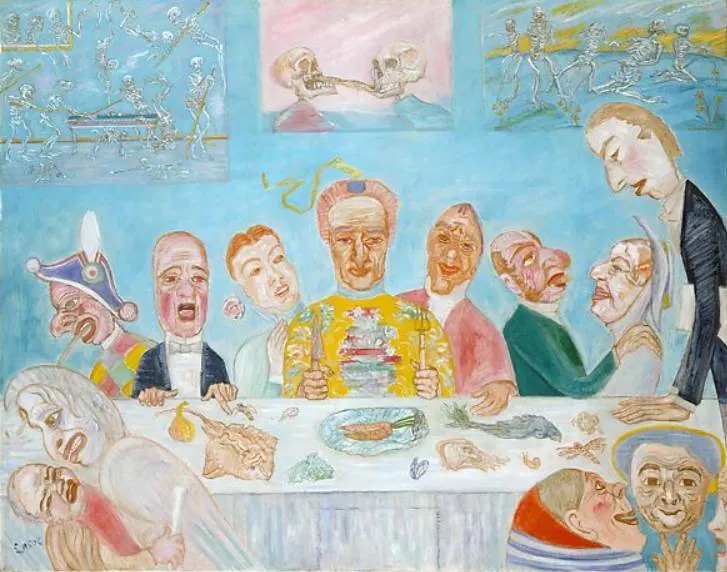When it comes to depictions of one of the most popular subjects in art history, you surely already know which painting makes the top of this list, right?
The iconic scene of Jesus Christ sharing his final meal together with his Apostles while mentioning that one of them will betray him is world-famous.
It’s often clear who Judas really is in paintings because of his facial expression or the fact that he looks away from the scene.
Because this painting has been produced from the Middle Ages to modern times, it’s great to learn about the development of art over the centuries as well.
In this article, I have compiled a list of some of the most famous Last Supper paintings in history.
1. Da Vinci’s Last Supper
- Date created: 1495-1498
- Dimensions: 460 × 880 centimeters (181 × 346 inches)
- Location: Santa Maria delle Grazie, Milan, Italy
The Last Supper is one of the ultimate masterpieces by Leonardo da Vinci (1452-1519, the Renaissance master and Italian polymath. He painted it on the walls of the refectory of the Convent of Santa Maria delle Grazie in Milan, Italy, where he was working for Duke Ludovico Sforza at the time.
Even the greatest genius in the world can make mistakes, and boy did da Vinci make one with this fresco. Instead of using the common paint applied to wet plaster, he used an experimental technique that resulted in the painting fading the moment it was completed. Luckily, it has been restored multiple times over the centuries so we can still admire it today.

2. Tintoretto’s Last Supper
- Date created: 1592-1594
- Dimensions: 365 × 568 centimeters (144 × 224 inches)
- Location: Church of San Giorgio Maggiore, Venice, Italy
The Last Supper by Tintoretto is the Mannerist version of the harmonious painting completed by Leonardo da Vinci. Jacopo Robusti (1518-1594) was one of the three great Venetian artists of the 16th century and created a distinctive style that clearly shows in this work of art.
Instead of painting a frontal view of the scene, he places the viewing point in the top corner of the room. This way, we not only get to see the table with Jesus and the Apostles but also the servants who are serving the food. This incredibly dynamic scene must have been revolutionary for contemporary viewers, that’s a certainty.
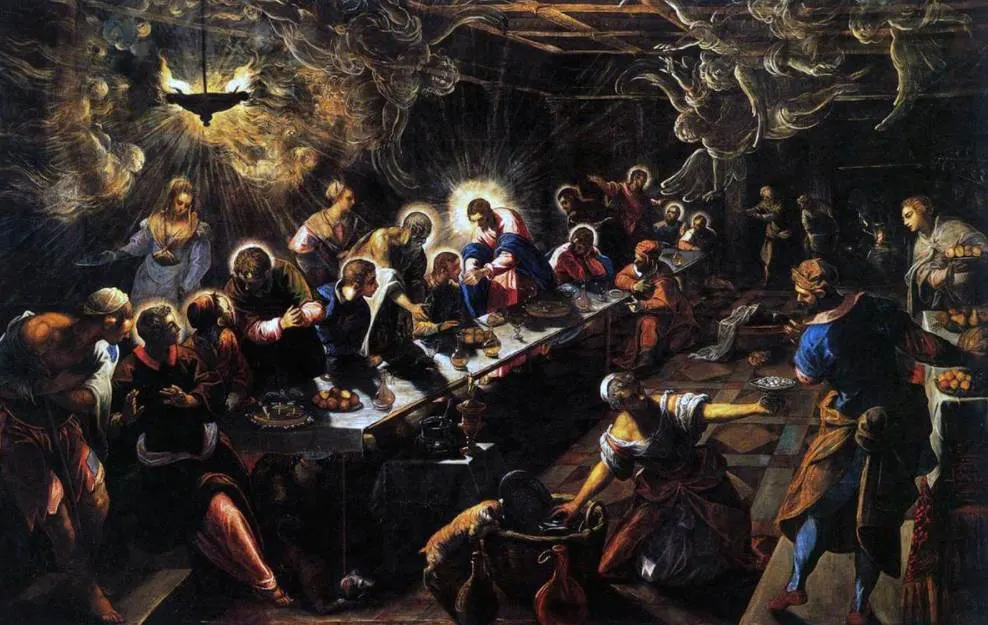
3. Rubens’s Last Supper
- Date created: 1630-1631
- Dimensions: 304 × 250 centimeters (120 × 98 inches)
- Location: Pinacoteca di Brera, Milan, Italy

Ruben’s painting of the Last Supper is the Baroque version of the scene and the second time that he tried to paint this subject. He already started working on it 2 decades earlier in 1611 but his patron backed out when they heard the price tag of 4,000 Guilders asked by Peter Paul Rubens (1577-1640).
Apart from Jesus, it’s one of the Last Supper paintings that makes it clear who Judas is because he can be seen staring at the viewer. Originally commissioned to serve as the altarpiece in the Church of St. Rombout in Mechelen, modern-day Belgium, this large work of art is one of the many masterpieces at the Pinacoteca di Brera in Milan today.

4. The Feast in the House of Levi – Paolo Veronese
- Date created: 1573
- Dimensions: 555 x 1,280 centimeters (18.2 x 41.99 feet)
- Location: Gallerie dell’Accademia, Venice, Italy
The Feast in the House of Levi is a painting by Paolo Veronese (1528-1588) and one of the largest canvases ever completed. It was commissioned as a Last Supper painting but the local religious authorities didn’t really appreciate the drunkards and monkeys that the artist included.
He almost got into serious trouble as the Italian artist was summoned to appear in front of the inquisition, but he solved the issue by changing the painting’s title. Paolo Veronese was famous for his lavish banquet scenes and this is one of the most stunning examples.

5. Triptych of the Last Supper – Dieric Bouts
- Date created: 1464-1468
- Dimensions: 88 × 71 centimeters (35 x 28 inches)
- Location: St. Peter’s Church, Leuven, Belgium
The Triptych of the Last Supper is also known as the “Altarpiece of the Holy Sacrament” and is a painting by Dieric Bouts (1415-1475). The Early Netherlandish artist was heavily influenced by his master Rogier van der Weyden and he was active in Leuven during the final decades of his life.
As the name suggests, the scene of Jesus Christ with his Apostles is the central panel of a triptych. The other panels depict 4 different scenes related to this event. It was the first Flemish painting of its kind and introduced the idea of a group painting around a table, making it one of Bouts’ ultimate masterpieces.

6. Bassano’s Last Supper
- Date created: 1546
- Dimensions: 168 x 270 centimeters (66.14 x 106.29 inches)
- Location: Borghese Gallery, Rome, Italy
The Last Supper by Jacopo Bassano (1510-1592) is a work by the Venetian artist who produced a very hectic scene. The overall composition was inspired by da Vinci’s masterpiece but the details are completely different as the Apostles appear as members of the lowest ranks of society and even barefoot.
This dynamic scene was typical of Mannerist paintings of the 16th century and was pretty much an extension of the foundation laid by High Renaissance artists. Another remarkable element is that Jesus is almost placed in the background as he stands behind a sleeping man.
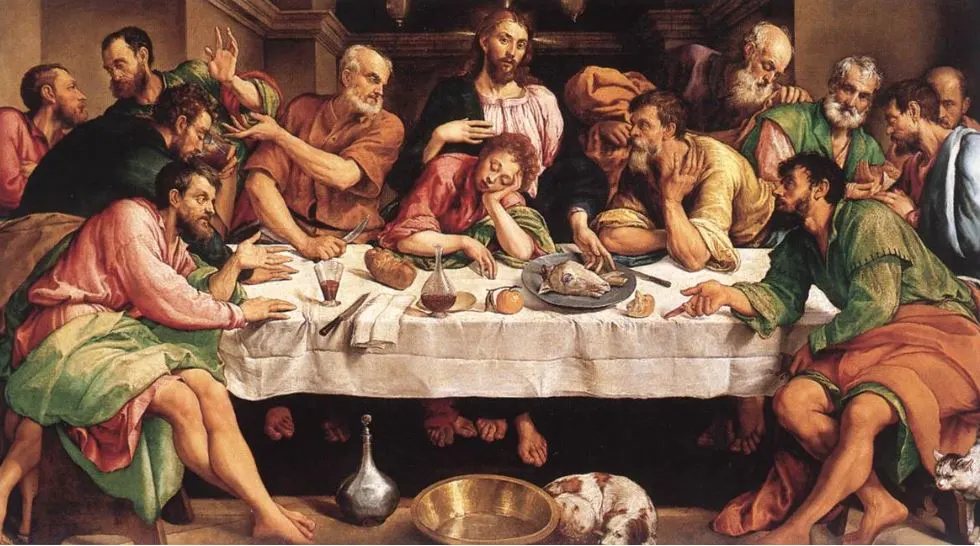
7. Von Uhde’s Last Supper
- Date created: 1886
- Dimensions: 206 x 324 centimeters (81.1 x 127.5 inches)
- Location: Staatsgalerie Stuttgart, Stuttgart, Germany
Von Uhde’s Last Supper is a 19th-century depiction of the scene painted by German artist Fritz von Uhde (1848-1911). He is best known for his genre paintings but also completed many works with a religious motif, including this monumental work of art.
His style was very similar to those of the Impressionist artists in France but he never lost his sense of Realism. This really shines through in this painting which provides a look at the table from behind Jesus as he carefully explains the upcoming betrayal to his followers.
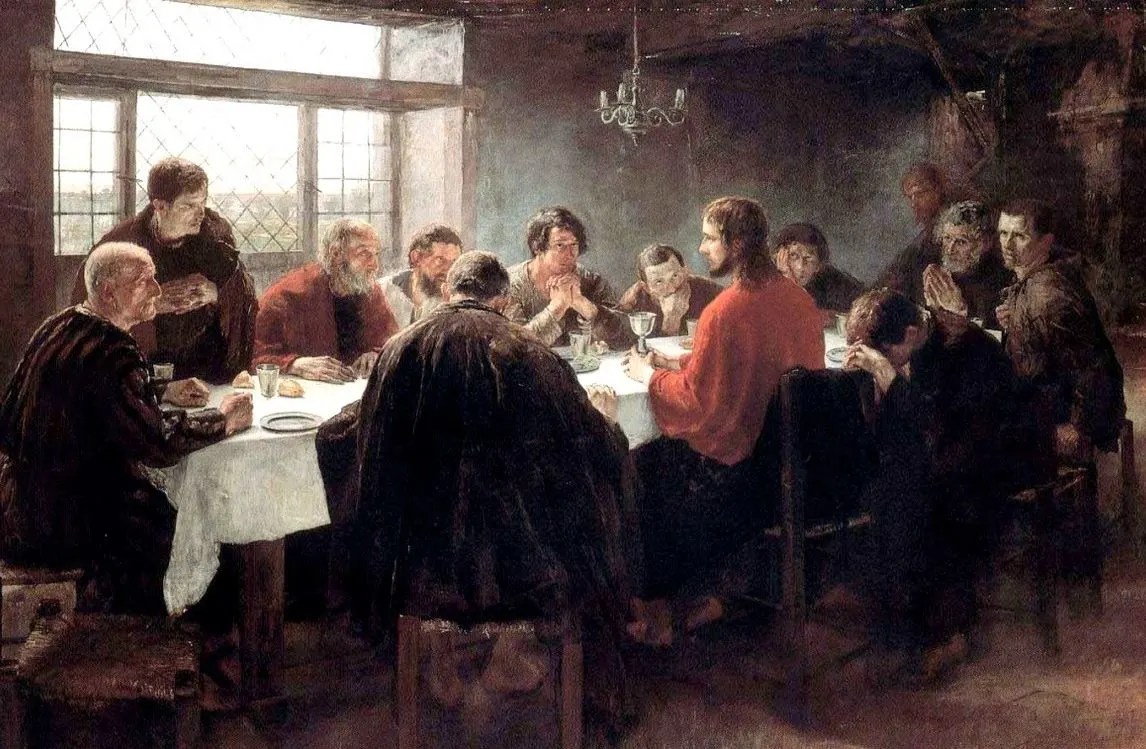
8. Emil Nolde’s Last Supper
- Date created: 1909
- Dimensions: 86 x 107 centimeters (33.85 x 42.12 inches)
- Location: National Gallery of Denmark, Copenhagen, Denmark
Emil Nolde (1867-1956) was one of the most famous Danish painters in history and was closely associated with a group of German Expressionist artists known as “Die Brücke.” His version of the Last Supper is the epitome of Expressionist paintings of the early 20th century.
His art is defined by expressive colors and this was inspired by a near-death experience in 1909. His style radically changed after this event and this becomes especially clear in his religious paintings. His wife Ada only had limited appreciation for this shift and I can definitely understand why.
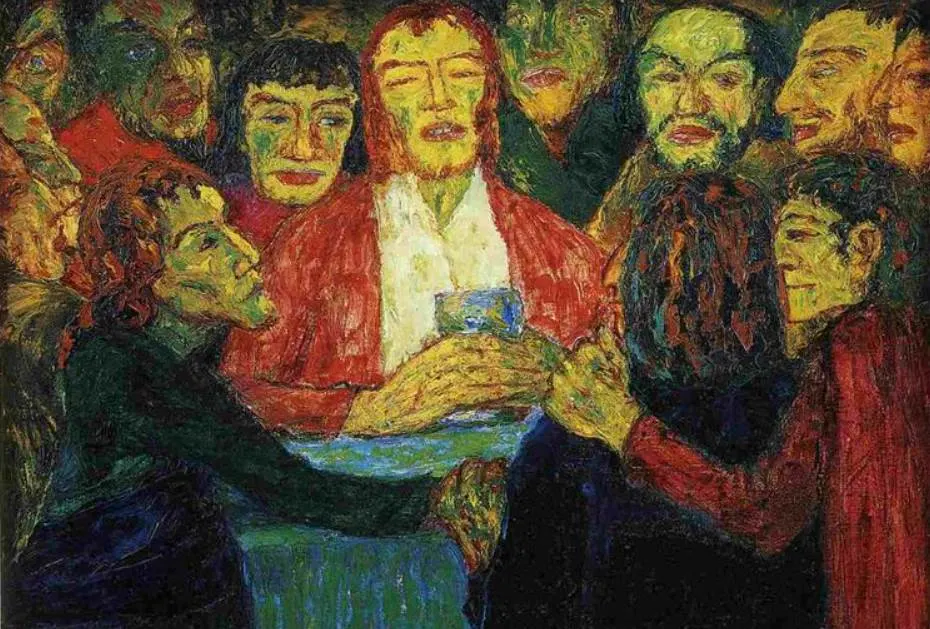
9. Nikolai Nikolaevich Ge’s Last Supper
- Date created: 1863
- Dimensions: 283 x 382 centimeters (111.4 x 150.39 inches)
- Location: State Russian Museum, Saint Petersburg, Russia
The Last Supper by Russian artist Nikolai Nikolaevich Ge (1831-1894) is another huge version of this popular scene in art history. He completed this work between 1861 and 1863 while the Realism artist was on an extended trip to Florence, Italy.
He brought the painting back home and it was exhibited at the exhibition of the Imperial Academy of Arts in Saint Petersburg in 1863 and it was a great success. It was purchased by Emperor Alexander II and Ge was awarded the title of professor of history painting shortly after.

10. Comical Repast (Banquet of the Starved) – James Ensor
- Date created: 1917-1918
- Dimensions: 115.6 x 145.4 centimeters (45.5 x 57.25 inches)
- Location: MET Museum, New York City, United States
Comical Repast (Banquet of the Starved) is the title of a painting by James Ensor (1860-1949), the Belgian artist who specialized in artworks that featured peculiar figures. These often wore masks and it allowed the Symbolist artist to transform his works into allegorical representations of popular events.
This work was clearly inspired by the numerous Last Supper paintings that had been produced over the centuries, but it had a deeper meaning. Art historians conclude that Ensor’s last supper was a critique of the German occupation of Belgium during World War I. This is emphasized by the meager meal that is served to the people at the table.
